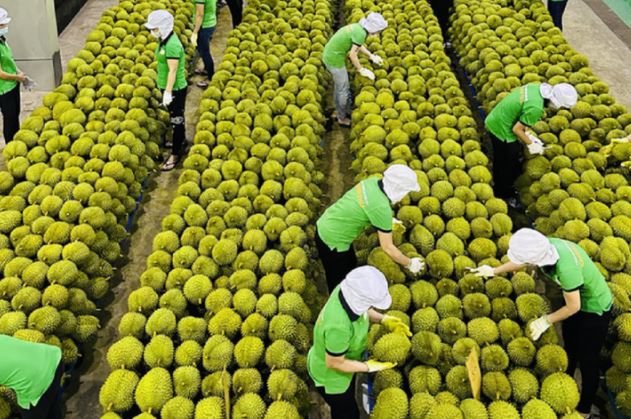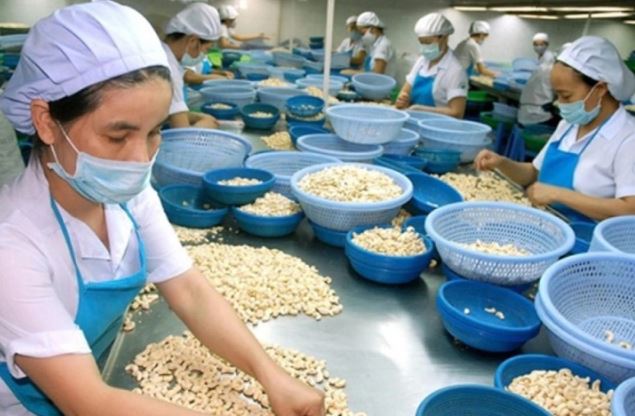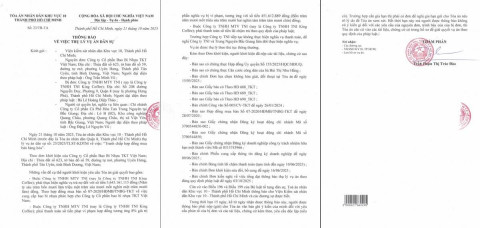Agricultural Exports - A Bright Spot for Vietnam’s Agricultural Industry
- 178
- Business
- 13:44 22/01/2024
DNHN - Vietnam’s agricultural sector has achieved remarkable success in agricultural exports in recent times. The impressive growth in agricultural exports has contributed to boosting the economy and affirming the sector’s significant role and position.

Factors Contributing to the Growth of the Agricultural Export Market
One of the notable highlights of Vietnam’s agricultural sector is the diversity of its export products. Vietnam is blessed with rich and diverse natural resources, providing a significant advantage in producing various agricultural products. Vietnam’s primary export commodities include coffee, rice, pepper, cocoa, cashew nuts, rubber, and aquatic products such as shrimp, tra fish, basa fish, and various fruits like pomelo, pineapple, mango, and coconut. This diversity demonstrates Vietnam’s ability to meet the demands of the diverse international market while generating high export value.
The robust growth of the agricultural sector is also supported by essential policies and measures from the government. Preferential tax policies and free trade agreements have facilitated agricultural exports. Additionally, technological advancements in agricultural production have enhanced the quality and value of products, increasing their competitiveness in the international market.
Another critical factor is the increased export capacity and market expansion. Vietnam has made efforts to expand its trade network with many countries worldwide by signing free trade agreements. The primary consumer markets for Vietnamese agricultural products include China, the United States, Japan, the EU, and countries in the ASEAN region. This indicates that Vietnam’s agricultural sector has effectively exploited market potential and seized opportunities to expand exports.
The growth of agricultural exports has generated numerous economic and social benefits for Vietnam. It has contributed to increasing farmers’ incomes and improving their livelihoods. Simultaneously, agricultural exports have created jobs and contributed to the country’s GDP growth.
However, it is essential to acknowledge the challenges faced by Vietnam’s agricultural sector. One of the primary challenges is food quality and safety. In the international market, the demand for food quality and safety is increasingly stringent. Therefore, to remain competitive and maintain export markets, Vietnam’s agricultural sector must ensure compliance with international standards and enhance product quality.
Another challenge is the impact of climate change and natural disasters. Vietnam is a country with a tropical climate, and the majority of its population lives in rural areas. Climate change, such as droughts, floods, and severe storms, can cause significant damage to agricultural productivity and hinder the ability to meet export demand.
To overcome these challenges, the agricultural sector needs to continue investing in research and technology development while strengthening cooperation among relevant agencies, businesses, and farmers. It is necessary to enhance quality control and food safety while raising awareness about maintaining a sustainable environment and responding to climate change.

Agricultural Exports to Remain a “Bright Spot” in the Market
Agricultural exports have proven to be a bright spot in Vietnam’s agricultural sector. The diversity of export products, favourable policies, and market expansion have created significant opportunities for the sector. However, to sustain and grow agricultural exports, the agricultural sector needs to address challenges related to product quality and the impact of climate change. By implementing appropriate measures, Vietnam’s agricultural sector is expected to continue affirming its position in the export market and contribute to the country’s economic development.
The Deputy Minister of Agriculture & Rural Development - Phung Duc Tien, stated that 2023 was a challenging year for exports. In the first 11 months, agricultural, forestry, and fishery exports reached 47.84 billion USD, a 2.7% decrease compared to the same period last year. However, the agricultural sector is still pursuing the export target of 54 billion USD.
According to data from the Ministry of Agriculture and Rural Development, in the first 11 months of 2023, several key agricultural products showed positive developments. The export value of the fruit and vegetable group reached 5.32 billion USD, an increase of 74.5%; rice at 4.41 billion USD, an increase of 36.3%; cashew nuts at 3.31 billion USD, an increase of 17.4%. Other products such as shrimp, tra fish, and forestry products are also being actively and vigorously exported to achieve the 2023 target of 54 billion USD.
“We can see that the structure of the agricultural export market has changed in 2023. China is the leading market with an export value to China of 11.5 billion USD, accounting for 23.2%, an increase of 18% compared to the same period last year; The United States reached 9.5 billion USD, accounting for 20.6%, a decrease of 17.9%, and Japan reached 3.5 billion USD, accounting for 7.4%, a decrease of 9.1%…”, Deputy Minister Tien shared.
According to experts, managers, and agricultural commodity forecasters, agricultural products, especially fruits, vegetables, and rice, will continue to thrive in 2024 due to several favourable factors. These include an increase in orders, sustained global demand for imports, and Vietnam’s recognition as a supplier of increasingly high-quality agricultural export products that meet the requirements of demanding markets.
The Vice Chairman of the Vietnam Food Association, Do Ha Nam, stated that rice exports would continue to be a bright spot in 2024 as the global demand for food, including rice, remains high. Due to the impact of El Nino, rice yields may decline.
Nghe Nhan
Related news
- Connecting Leaders, Shaping the Future: Strategic Leadership Planning Meeting – CorporateConnections Hanoi A
- Sunlight - Unilever Vietnam Recognized for Outstanding Contributions to the National Initiative Supporting Women Entrepreneurs
- Deputy Prime Minister Nguyễn Chí Dũng: “The country’s major challenges weigh heavily on my mind — and we must resolve them together.
- Unitsky String Technologies signs cooperation agreements with three Vietnamese partners, opening a new direction for smart mobility and sustainable development
- When artists do business – livelihood is no poetry!
- Before the D‑day to abolish flat‑rate tax: Fear of technology and costs leave small traders struggling to adapt
- Vietnamese enterprises at a crossroads: the impact of a potential US–China deal
- "Digital technicians" must not be forgotten if Vietnam aims to meet its strategic goals
- HDBank: Impressive profit growth, leading in profitability and advancing international integration
- TNI King Coffee sued for over VND 5 Billion in unpaid debts
- VINASME and Jeonnam Technopark Sign MOU on technology cooperation, human resource training, and trade promotion
- Vietnamese entrepreneurs strengthen ASEAN connectivity in the digital iIntegration era
- Prime Minister: Vietnam aims to become a regional logistics hub
- Vietnam upgraded to Secondary Emerging Market by FTSE Russell
- Hanoi’s economy grows 7.92% in first nine months of 2025, FDI surges nearly threefold
- Vietnam’s strong gdp growth fails to ease labor market distress
- US tariffs on Brazil propel Vietnam’s pangasius into global spotlight
- VietLeap AI Accelerator launches: A strategic springboard for Vietnam’s AI startups
- CICON expands strategic alliances: A new step forward in Vietnam–Korea business connectivity
- What must Vietnamese enterprises do to maintain their position in the global supply chain?
Đọc thêm Business
Connecting Leaders, Shaping the Future: Strategic Leadership Planning Meeting – CorporateConnections Hanoi A
"Your network is your most powerful flowing asset. It generates value, multiplies opportunities, and accelerates your influence across borders."
Innovative ESG enterprise: Trạm Xe Việt startup proposes solutions to build a green mobility ecosystem
As Vietnam commits to achieving Net Zero by 2050 and tightens emissions standards, the transportation sector faces unprecedented pressure to transform.
Deputy Prime Minister Nguyễn Chí Dũng: “The country’s major challenges weigh heavily on my mind — and we must resolve them together.
On the morning of November 26, 2025, Deputy Prime Minister Nguyễn Chí Dũng chaired a high-level working session at the National Innovation Center (NIC) in Hòa Lạc.
Unitsky String Technologies signs cooperation agreements with three Vietnamese partners, opening a new direction for smart mobility and sustainable development
The signing ceremony took place in Minsk, Belarus, on November 28, 2025.
Before the D‑day to abolish flat‑rate tax: Fear of technology and costs leave small traders struggling to adapt
From 1 January 2026 the flat‑rate tax regime will be abolished. Small business households will be required to declare tax based on actual revenue. MISA supports the transition with technology to help micro‑merchants adapt smoothly and transparently.
Vietnamese enterprises at a crossroads: the impact of a potential US–China deal
As the world closely monitors every shift in US-China relations, emerging signals of a strategic agreement between the two global powers are raising hopes for global economic stability.
HDBank: Impressive profit growth, leading in profitability and advancing international integration
Ho Chi Minh City Development Joint Stock Commercial Bank (HDBank, stock code HDB) announced its consolidated profit before tax for the first 9 months of 2025 reached VND 14,803 billion, marking a 17% increase year-on-year (YoY).
TNI King Coffee sued for over VND 5 Billion in unpaid debts
On October 21, 2025, the People’s Court of District 10 in Ho Chi Minh City officially accepted a civil lawsuit concerning a commercial contract dispute between TKT Vietnam Plastic Packaging Joint Stock Company and TNI King Coffee Co., Ltd.
VINASME and Jeonnam Technopark Sign MOU on technology cooperation, human resource training, and trade promotion
On October 15, 2025, in Hanoi, VINASME and Jeonnam Technopark (Korea) signed an MOU to promote trade, advance technology transfer, and develop human resources between enterprises of both nations.
Vietnamese entrepreneurs strengthen ASEAN connectivity in the digital iIntegration era
On the occasion of Vietnam Entrepreneurs’ Day (October 13), an international event themed “Integration – Innovation – Sustainable Development” was solemnly held in Ho Chi Minh City.











